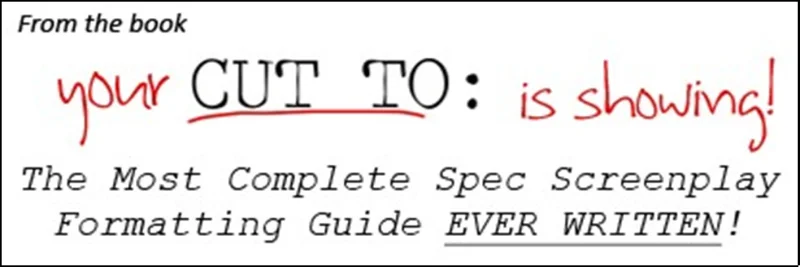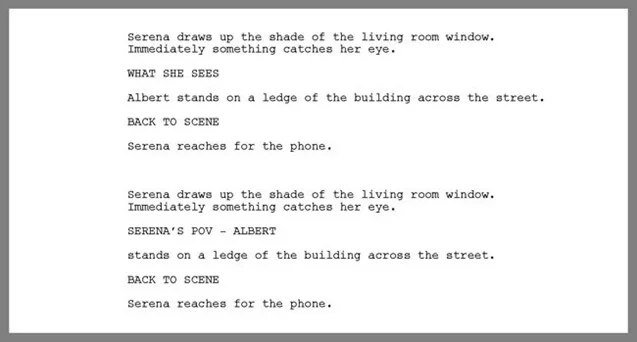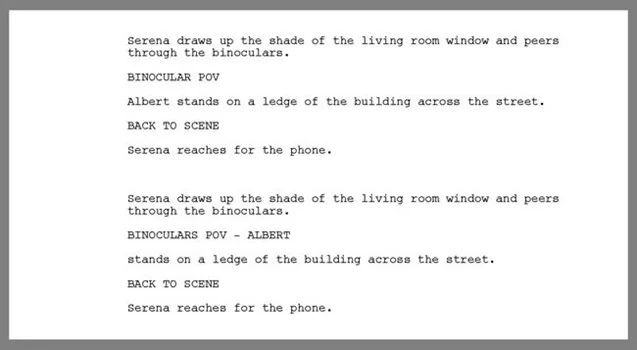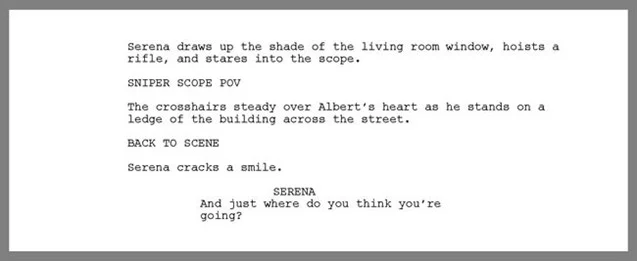
Screenwriting ABCs Script Formatting

POV Shots
A lot of times a character will see something outside of the camera's view, and then the camera will cut over to show the audience just what it is the character sees.
Such a sequence is called a Point-of-View (POV) Shot.
POV Shots are incredibly common in screenplays, and they can be more than just what the character is seeing through his naked eye. It can also be what characters see through binoculars, sniper scopes, microscopes, night vision goggles, telescopes, etc.
Common POV Shot:
Of course, the most common POV shot is just what a character sees through his or her naked eye, such as when a character reacts to something off screen and then the camera pans or cuts over to show what the character sees. Maybe a woman at a funeral gasps at something the audience can't see, and then the camera cuts over to her thought-to-be-dead husband walking into the funeral parlor.
Here is how a common POV Shot can be formatted:

Pretty simple, huh?
The Subheading SERENA'S POV is all that is necessary to call out the POV Shot.
You'll notice that the writer draws the audience back from the POV shot with BACK TO SCENE. It is always necessary to queue to reader as to where the POV shot ends.
Of course, this isn't the only way to format a common POV shot. Here are a couple more examples:

In the first example above, WHAT SHE SEES is the Subheading that calls out the POV Shot. Nothing wrong with that.
In the second example, we use a variation of SERENA'S POV as used before, this time adding the Subject of Shot (ALBERT) to the Subheading. Notice after the Subheading, I didn't capitalize the "s" in "stands." That sentence is basically a continuation of a sentence started in the Subheading with ALBERT.
Notice that in each example, the writer brings the audience BACK TO SCENE.
Of course, the Common POV Shot is sometimes overused, and many times unnecessary. Here is how the same scene can be written so that a POV Shot is implied, but not specifically called out:

POV Shots Through Lenses:
Many times, POV Shots will be through the lens of some device, such as binoculars. In such cases, the call out of the POV Shot IS necessary.
Check out this example:

Nothing complicated there.
But, as usual, there is more than one way to handle the formatting. Here are two more ways to pull that off:

Those examples require no explanation.
So let's take the same scene, but this time let's peer down a sniper scope:

And just like that, Serena has gone from concerned citizen to cold-blooded assassin.
How would the audience look at the world on a molecular level? Maybe something like this:

Obviously, the options are endless. Just stick to the basic formatting.
Mystery POV:
Ever get the feeling you are being watched?
Sometimes the audience will be looking through the eyes of a person (or a creature) who is unseen by the character on screen and who may be a mystery to the audience.
Think of the classic Mystery POV Shots from the film Predator, where the creature watches his prey using a sort of thermal vision.
Here is how a Mystery POV might be formatted:

Maybe that is the end of the scene, which means a Master Scene Heading will follow leading into the next scene. Maybe the scene continues from there, which means the writer will have to bring the audience BACK TO SCENE.
Either way, looking through the eyes of something the audience knows nothing about is kinda creepy.
-----------------------
For more screenplay formatting rules and advice, check out the book, Your CUT TO: Is Showing! by T. J. Alex or visit www.scripttoolbox.com. From there, please like the page on Facebook, and share it with your friends.
If you have any formatting questions, please email T. J. at tj@tjalex.com.




